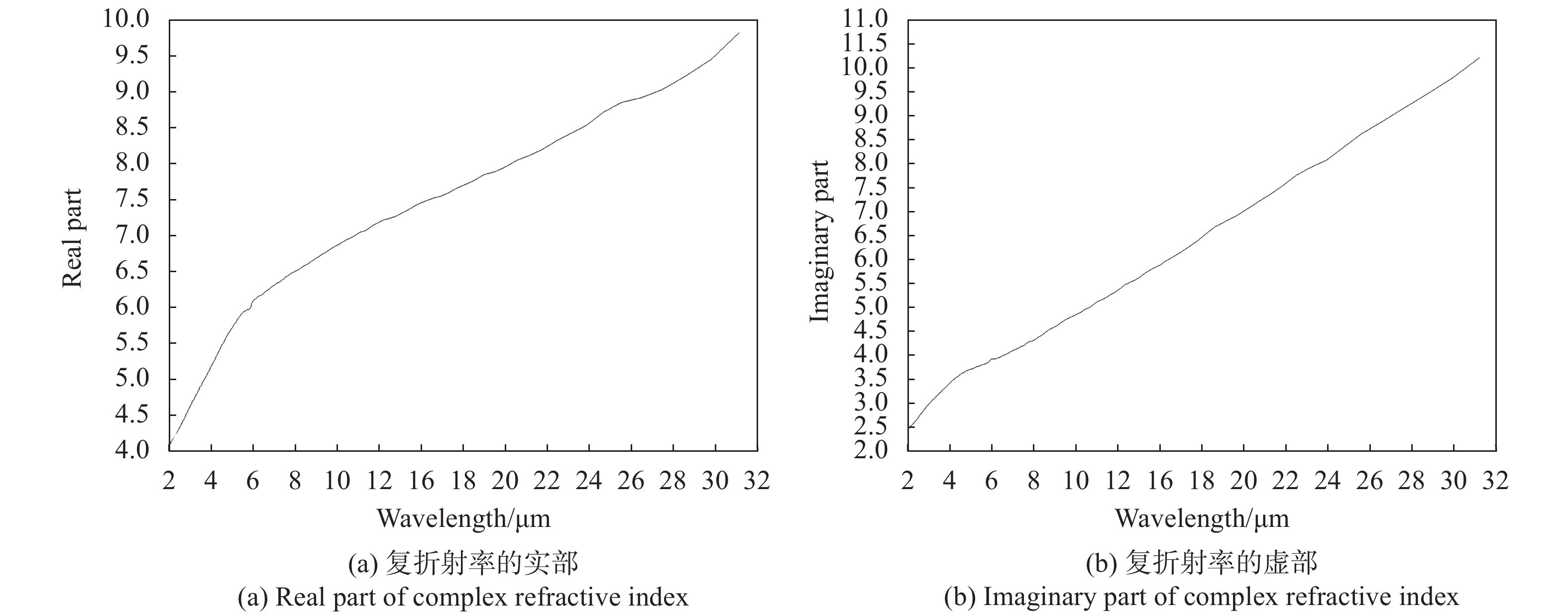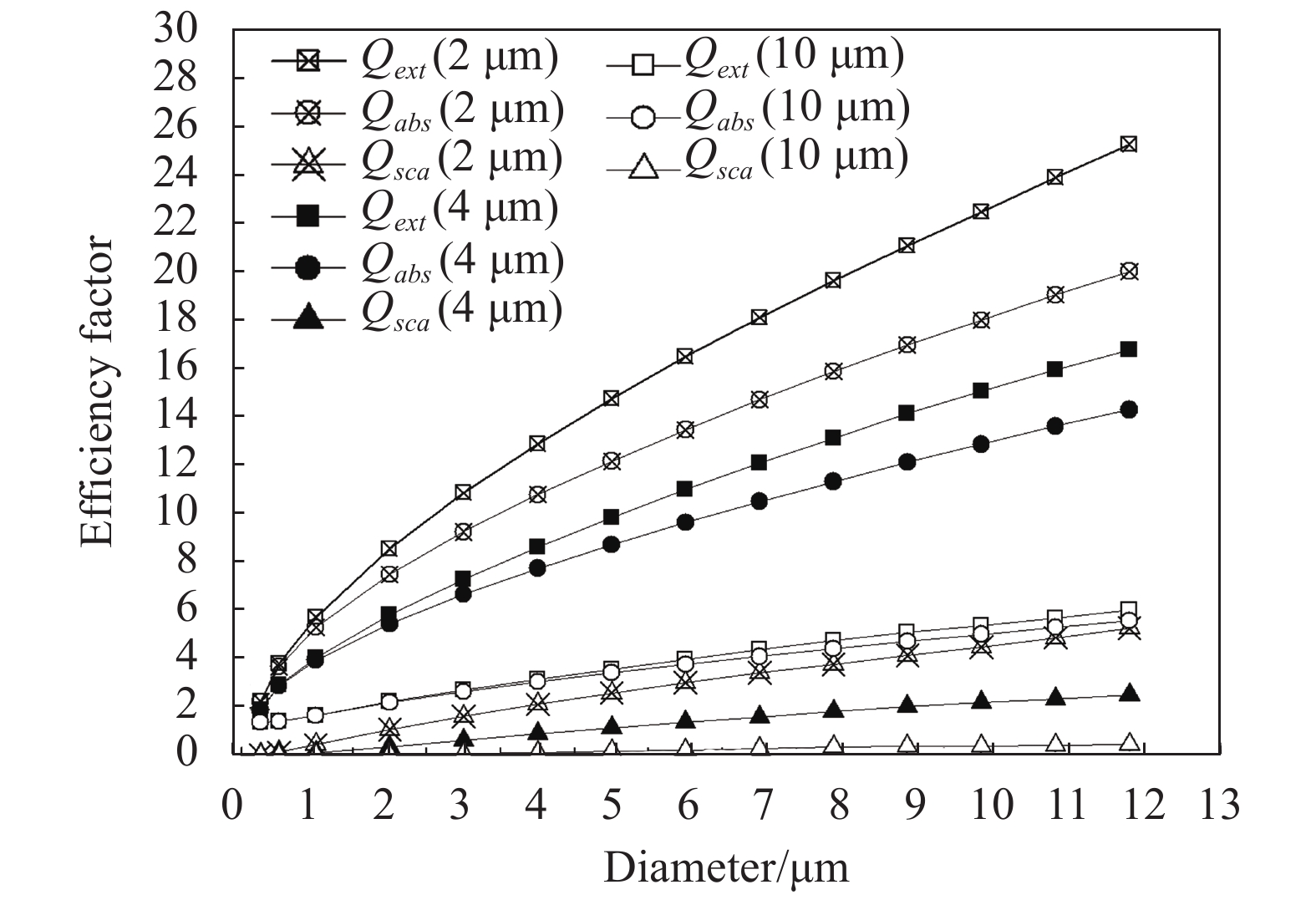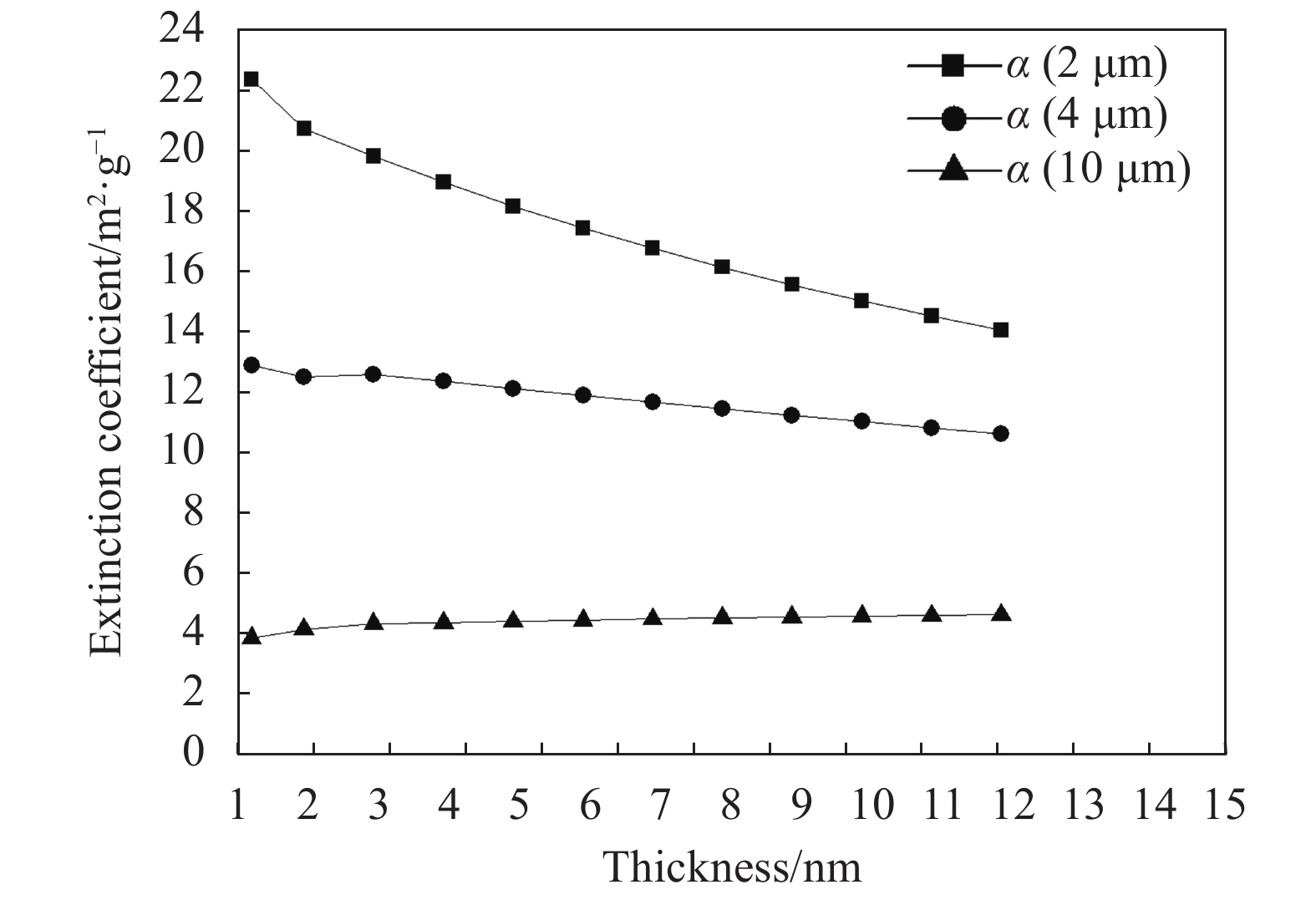-
烟幕是一种实用、高效的无源干扰手段,在光电对抗领域备受关注。在光电侦察和制导武器迅猛发展和大量使用的今天,战场生存环境越发艰难,战场防护的军事需求对烟幕遮蔽能力的要求越来越高,新型烟幕材料成为各国竞相发展的重点。石墨烯(Graphene)是目前发现的具有单原子厚度的二维纳米碳材料,具有特殊的微观结构,与传统烟幕材料相比,不仅密度更低、比表面积更大,而且具有高电导率和优异的悬浮特性,兼具纳米和微米级材料的优异特性,是一种极具潜力的新型红外干扰烟幕材料[1-3]。然而,石墨烯在红外波段的消光性能研究还较少。
经研究证实,大多数烟尘粒子的形状都是非球形的。为了使问题简化,通常的做法是把烟幕粒子作为球形粒子来处理,惯用成熟的米氏理论分析其散射和消光特性,由于实际烟幕粒子的形状千差万别,计算结果难免会产生各种不同程度的误差。对于非球形粒子,离散偶极近似(Discrete Dipole Approximation,DDA),是近些年发展起来的一种可靠高效的数值处理方法。该方法由Purcell和Pennypacker 1973年首先提出,经过不断的发展和完善,已经拓展到可以计算各向异性、任意形状及尺寸的非球形粒子的吸收、散射及消光性能,在计算光与纳米粒子的相互作用方面已经显示出了较强的优越性[4-9]。
复折射率是研究烟幕材料消光性能的重要光学常数。采用离散偶极近似方法计算石墨烯粒子的红外消光性能,首先要获得材料在2~14 μm红外波段的复折射率。目前,石墨烯在紫外、可见光及近红外波段(210~999 nm)的复折射率已有部分学者进行了相关研究[10],对于中远红外波段复折射率的研究鲜有相关报道。目前可有效测量材料光学常数的实验方法主要有反射法、透射法、吸收光谱法和椭偏法等。其中,椭偏法是这几种方法中测量最精确的,研究表明,椭偏测量在60°~70°的入射角时,灵敏度最高,可同时测量得到复折射率和复介电函数的实部和虚部,且对材料无限制性,应用广泛[11]。
文中采用压片法制备了石墨烯样品压片,利用红外椭偏仪测定了样品在2~30 μm红外波段的椭偏参数,计算得到石墨烯在2~30 μm波段复折射率的实部和虚部,采用离散偶极近似方法对石墨烯粒子的在2~14 μm波段的红外消光性能进行了数值计算,并对其消光性能与波长、直径和厚度等关系进行了分析,为进一步开展石墨烯烟幕红外消光机理的理论研究提供了一定的方法和借鉴。
-
LN-2NA石墨烯粉体(上海利物盛企业集团有限公司生产,真密度≤2.2 g/cm2,比表面积>150 m2/g,粒子直径分布在0.5~6 μm之间),目测为黑色、蓬松、轻盈粉末。透射电镜(TEM)分析采用美国FEI公司的Tecnai G2F30场发射透射电镜。
石墨烯微观形貌HTEM测试结果如图1所示。图1(a)为5 k倍率下的石墨烯的HTEM图,从图中可以看出,石墨烯粒子呈透明薄层状,存在堆叠形貌,片层尺寸很小,片层边缘有翘起,表面存在褶皱,粒子横向尺寸约为0.5~6 μm;图1(b)为500 k倍率下的石墨烯粒子片层侧面的HTEM图,从图中可以观察出石墨烯粒子片层间存在堆积,片层厚度在5 nm以下,层数为6~10层左右。
-
量取一定体积的石墨烯粉体,采用769YP-15A型粉末压片机,在压强设定为15 MPa下进行压片,脱模后得到表面较光滑、平整的压片样品,经测量压片的直径为13 mm,厚度为0.14 mm。为进一步减小压片表面的粗糙度,降低散射对仪器信号的干扰,用1200目的砂纸对压片背面进行打磨处理。
-
椭偏法的基本原理是通过测量样品反射光波的椭圆偏振态,分析反射光波的振幅和相位得到光学常数[11]。椭圆偏振光谱测量是一种无破坏性的非接触的光学分析技术,常用于研究材料光学性质[12]。实验采用椭偏测量方法,利用打磨处理过的压片测量石墨烯在红外波段的椭偏参数。测量仪器使用美国J. A. Wallam公司生产的IR-VASE Mark Ⅱ型变温红外椭圆偏振光谱仪,仪器工作波段为2~30 μm,测量入射角度为70°,经测量获得压片在2~30 μm红外波段的椭圆偏振参数∆和Ψ,测试结果如图2所示。
-
将测量得到的椭偏参数输入到IR-VASE Mark Ⅱ型变温红外椭圆偏振光谱仪自带的数据处理主程序wvase32中,经计算处理最终得到石墨烯压片的复折射率实部n和虚部k,计算结果如图3所示。
从图3中可以看出,在2~30 μm红外波段,石墨烯压片复折射率的实部大于4.09,虚部大于2.52,且随着波长的增加而增大。
文中所用的石墨烯样品为粉体材料,制备成样片后,粉末间的孔隙被进一步压缩而成为体材料,复折射率可能会随着材料物理形貌的改变而产生变化,需对石墨烯压片的表面微观形貌和结构进行分析表征,SEM分析采用美国FEI公司的QUANTA FEG 450扫描电镜,测试结果如图4所示。
图4为石墨烯压片的表面和边缘的SEM微观形貌图。由图4(a)可以看出,石墨烯粒子片层在外力的作用下排列比较紧密,粒子间存在一定的间隙,从压片表面看,粒子仍然以分散的形态存在;由图4(b)可以看出,利用扫描电镜观测压片边缘,发现压片内部粒子保持薄层堆积状形态,粒子的物理形貌并没有受外力影响而发生明显的变化。基于上述测试分析,可以认为计算得到的石墨烯样片的复折射率等同于石墨烯粒子的复折射率。
-
根据DDA算法的有关要求,利用入射波长、粒子形状参数、粒子的有效半径、粒子随波长变化的复折射率等计算石墨烯粒子在红外波段的消光因子和消光系数。
-
离散偶极近似方法相对于常见的T矩阵等方法而言,对计算机的要求较低,适用范围更广,程序处理也较为简单,其基本原理如下[13]:
该方法利用大量偶极子组成的阵列来模仿实际粒子,通过求解这些偶极子在入射电磁波照射下的极化度来获得粒子吸收、散射电磁波的性质,粒子对入射电磁场的作用是单个偶极子相互作用累加的结果,可以实现粒子的散射、吸收、消光效率因子(Qsca、Qabs、Qext)和近场等的计算及呈现,且Qext= Qsca+ Qabs。
DDSCAT是由普林斯顿大学的Bruce T. Draine和加利福尼亚大学的Piotr J. Flatau编制的利用DDA算法计算电磁波与任意形状粒子作用引起的电磁吸收和散射问题的Fortran开源程序,可在Windows系统或Linux系统下运行,目前版本为DDSCAT 7.3[14]。
在DDA算法中,粒子的大小用有效半径aeff来描述,也就是与粒子体积相等的球的半径:
式中:V为粒子体积,V=Nd3;N为程序自动划分生成的偶极子的个数;d为偶极子的大小,也就是生成的偶极子立方体的边长。
质量消光系数α是表征烟幕粒子消光性能的重要参数,与消光效率因子Qext存在如下关系:
式中:ρ为材料粒子的密度。
利用DDA方法计算一个等效半径为aeff的粒子的消光性能时,偶极子数目N应满足以下条件:
式中:kaeff为粒径参数,kαeff=(2π/λ)αeff,λ为入射波长;|m|为粒子复折射率的模。
利用Windows系统运行下的DDSCAT程序7.3.0版本进行石墨烯粒子红外消光性能的相关数值计算,石墨烯粒子的几何形状可近似为圆片形。在运用DDSCAT 7.3.0程序进行计算时,需要把石墨烯的复折射率数据编译成可执行文件。石墨烯是典型的二维晶体,具有各向异性,选择适合各向异性材料的模型UNIAXICYL进行粒子形状、有效半径等参数设置,选择2个入射波极化方向,取其平均值作为计算结果,并利用粒子的旋转参数计算粒子所有空间取向平均的消光性能。
单层石墨烯的理论厚度仅为0.335 nm,由于实验条件的不同,测量结果也有所差别,一般单层石墨烯的实验测量厚度为0.4~1.0 nm[15]。计算中粒子的尺寸根据石墨烯样品TEM图进行假定。
-
计算直径为5 μm、厚度为5 nm的石墨烯圆片粒子在2~14 μm红外波段的消光性能,结果如图5所示。
从图5中可以看出,在2~14 μm波段,石墨烯粒子的质量消光系数保持在2.5 m2/g以上,理论上表明石墨烯具有非常优异的红外消光性能,是粒子对红外散射和吸收共同作用的结果,其中吸收衰减大于散射衰减作用。石墨烯粒子对近红外能够产生较好的衰减效果,是由于与近红外波长相当的粒子产生较强米氏散射引起的衰减[2]。石墨烯粒子对红外表现出较强的吸收衰减,是由于石墨烯具有特殊的电子能带结构,石墨烯的碳原子sp2杂化构成σ键,p轨道上的剩余的一个电子形成大π键,π电子在纳米量级的石墨烯表面可以自由移动,赋予其良好的导电性,在边界条件的约束下受到激发会产生振-转能级跃迁,从而产生新的吸收通道,对红外形成较为强烈的吸收衰减[1]。
-
计算不同直径,厚度为5 nm的石墨烯圆片粒子对2、4 μm和10 μm红外辐射的消光性能,结果如图6和图7所示。
从图6中可以看出,石墨烯粒子对波长为2、4、10 μm红外的消光效率因子均随着粒子直径的增加而增大,同时粒子也表现出在近红外波段的消光性能较强,明显好于中远红外波段。除石墨烯本身的强吸收作用外,主要是由于在厚度不变的情况下,随着粒子直径的增加,粒子的粒径参数逐渐变大,与近红外波长较为相近,导致其对该波段的米氏散射较强,同时随着粒径参数的增加,粒子的吸收截面变大,有利于对红外的吸收。从图7中可以看出,不同片层直径的石墨烯粒子对于波长为2、4、10 μm红外的质量消光系数范围分别为21.6~17.3 m2/g、17.0~11.5 m2/g、12.4~4.1 m2/g,其中直径0.25~1 μm粒子的质量消光系数最大,直径1~4 μm粒子的质量消光系数随直径的增加逐渐减小,当直径大于4 μm时,石墨烯粒子对各波段红外的消光能力受粒度变化的影响很小。
-
计算不同厚度,直径为5 μm的石墨烯圆片粒子对2、4、10 μm红外辐射的消光性能,计算结果如图8和图9所示。
从图8中可以看出,石墨烯粒子对近红外波段的消光性能好于中远红外波段,对波长为2 μm红外的消光效率因子随着粒子片层厚度的增加而增大,当粒子厚度达到10 nm时,消光效率因子的增加趋于平稳,而对波长为4、10 μm红外的消光效率因子均随着粒子片层厚度的增加而增大。此外,粒子对于波长为2 μm红外的吸收效率因子在厚度4 nm处出现明显的下降趋势,粒子对波长为4 μm红外的吸收效率因子在厚度9 nm处出现不变甚至下降的趋势,而粒子对于波长为10 μm红外的吸收效率因子随厚度增加呈缓慢的增加趋势。研究表明,单层石墨烯的电导率最高,且电导率随着层数的增加而降低并趋于不变[16]。石墨烯对电磁波的吸收衰减主要来源于高电导率引起的介电损耗。随着粒子厚度的增加,电导率有所减小,导致粒子对红外的吸收作用有所减弱,而入射电磁波的频率越高,趋肤深度越小,电磁波在介质中的传输距离越短。因此,2 μm的吸收效率因子比4、10 μm的吸收效率因子更早的表现出较为明显的减小趋势,从而在4 nm处出现了吸收效率因子下降的拐点。从图9中可以看出,不同片层厚度的石墨烯粒子对于波长为2、4、10 μm的红外辐射同样表现出在近、中红外波段具有更大的质量消光系数,而在远红外波段消光能力较弱,这与波长越长越难干扰的规律基本一致。
-
通过压片法制备了石墨烯样片,利用红外椭偏仪测定了样片在2~30 μm红外波段的椭偏参数,计算得到石墨烯在中远红外波段的复折射率,所得数据对于石墨烯的红外消光特性和消光机理研究具有一定的参考价值。由于至今未见有关石墨烯中远红外波段复折射率数据的公开报道,所得数据还需其他实验进行校正。
采用离散偶极近似方法计算了石墨烯粒子的消光(散射、吸收)效率因子、质量消光系数与入射波长、粒子直径及厚度的关系。计算结果表明,石墨烯在2~14 μm波段具有优异的红外消光性能,粒子在近、中红外波段的消光性能好于远红外波段,其消光性能主要取决于材料的吸收性能,吸收作用大于散射作用。这为石墨烯红外消光性能的实验测试评价提供了理论依据,同时也为石墨烯材料在无源干扰光电对抗领域中的应用提供了必要借鉴。
Complex refractive index and extinction performance of graphene in infrared bands
doi: 10.3788/IRLA20200246
- Received Date: 2020-06-22
- Rev Recd Date: 2020-09-30
- Available Online: 2021-05-12
- Publish Date: 2021-04-30
-
Key words:
- graphene /
- complex refractive index /
- discrete dipole approximation (DDA) /
- infrared /
- extinction coefficient
Abstract: As a new type of two-dimensional nano-carbon material, graphene has great potential application value in infrared interference, and its infrared extinction characteristics are worthy of in-depth study. In this paper, the ellipsometric parameters of graphene pellet in the infrared bands were measured by infrared ellipsometry, and the complex refractive index was calculated. Subsequent, the relationships between efficiency factors, extinction coefficient and the incident wavelength, diameter, thickness in 2-14 μm wavebands of graphene particles were calculated with discrete dipole approximation (DDA) method. Results show that graphene has excellent infrared extinction performances in 2-14 μm wavebands, and the extinction performance of the particles to near-infrared and mid-infrared radiation is better than that of far-infrared band. The extinction performances mainly depend on the absorption properties of the particles, and the absorption is better than the scattering effect. The extinction efficiency factor and extinction coefficient gradually decrease with the increase of wavelength. The extinction efficiency factor increases with the increase of the particle's diameter. The extinction coefficient in near-infrared and middle-infrared bands is better than that in far-infrared bands, of which the particles with diameter of 0.25-1 μm have the largest extinction coefficient. The extinction coefficient of the particles with diameter of 1-4 μm decreases slowly with the increase of diameter, while the extinction ability of particles with diameter larger than 4 μm is little affected by the change of particle size. The extinction efficiency factor gradually increases with the increase of the thickness of graphene sheet, the extinction coefficient in near-infrared and middle-infrared bands decreases with the increase of the thickness, while the extinction coefficient in far-infrared bands is less affected by the change of particle thickness.






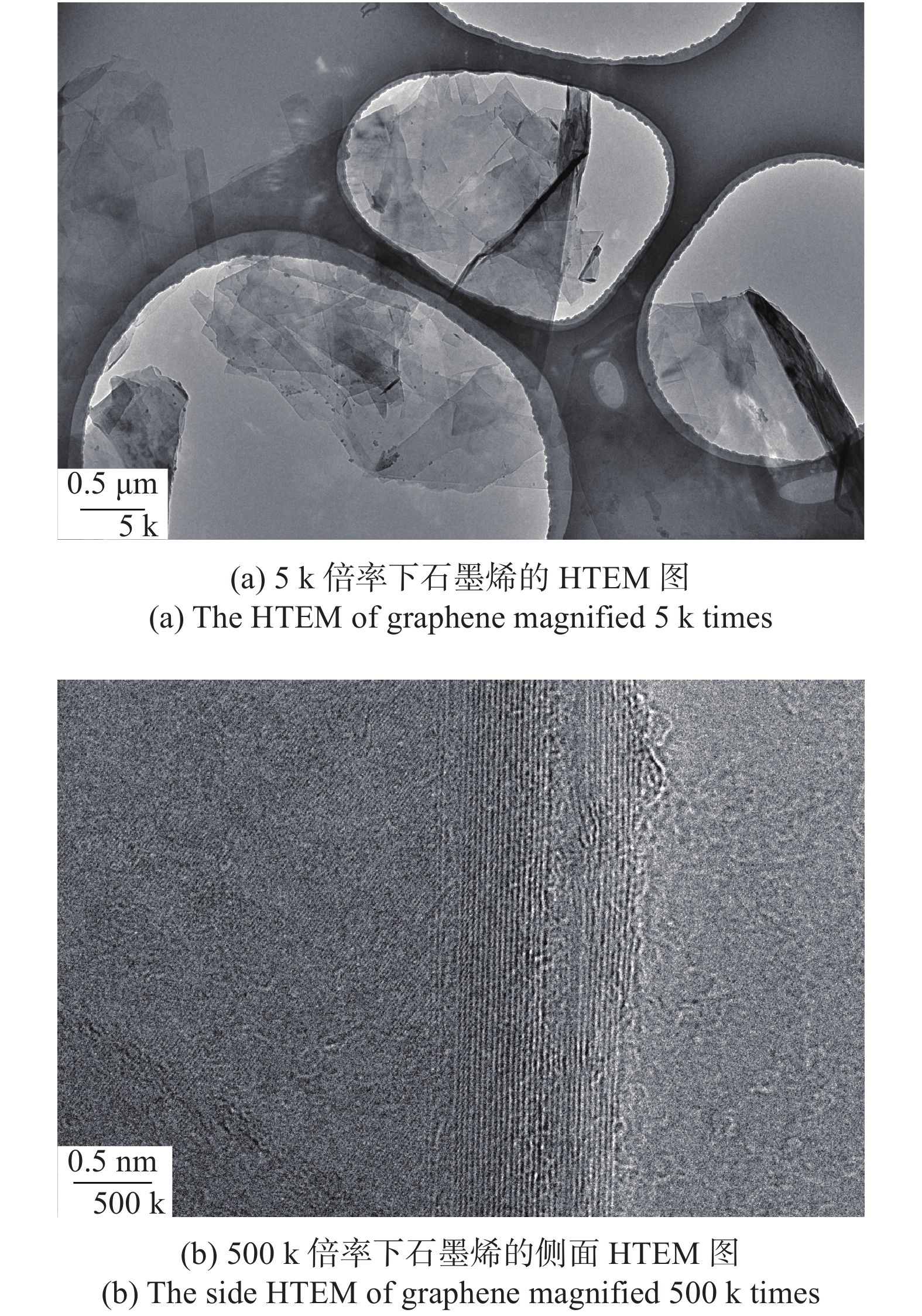


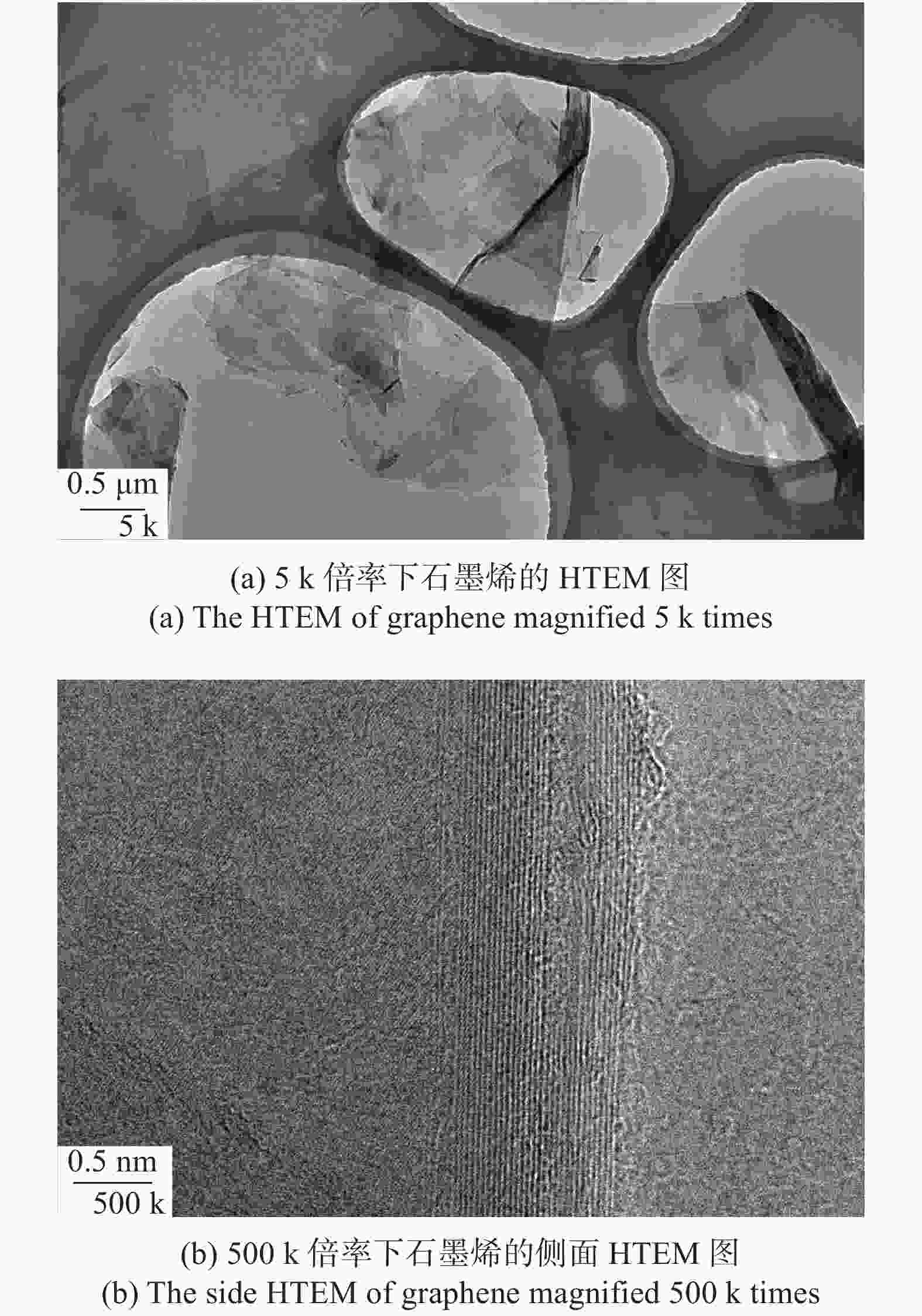
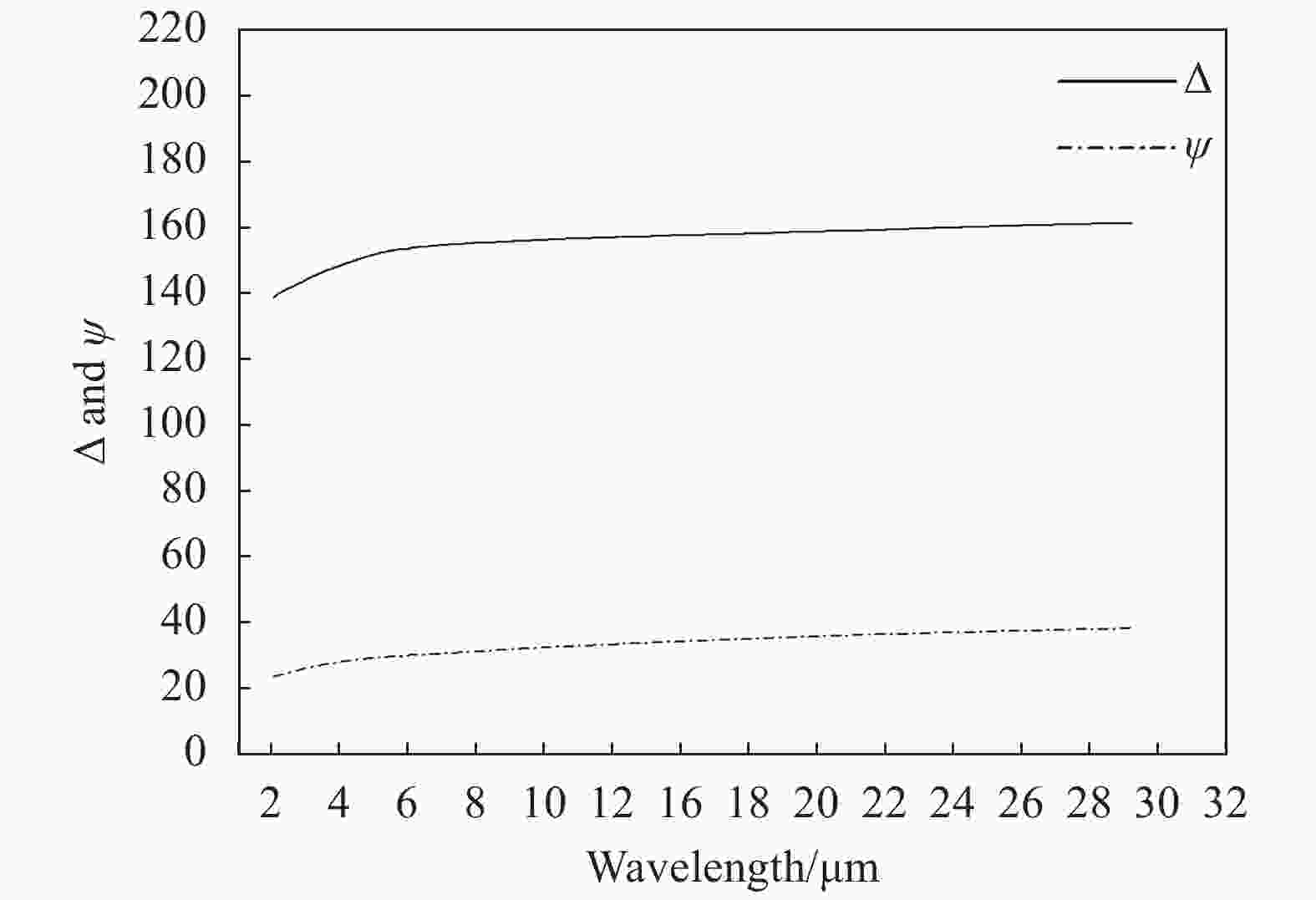

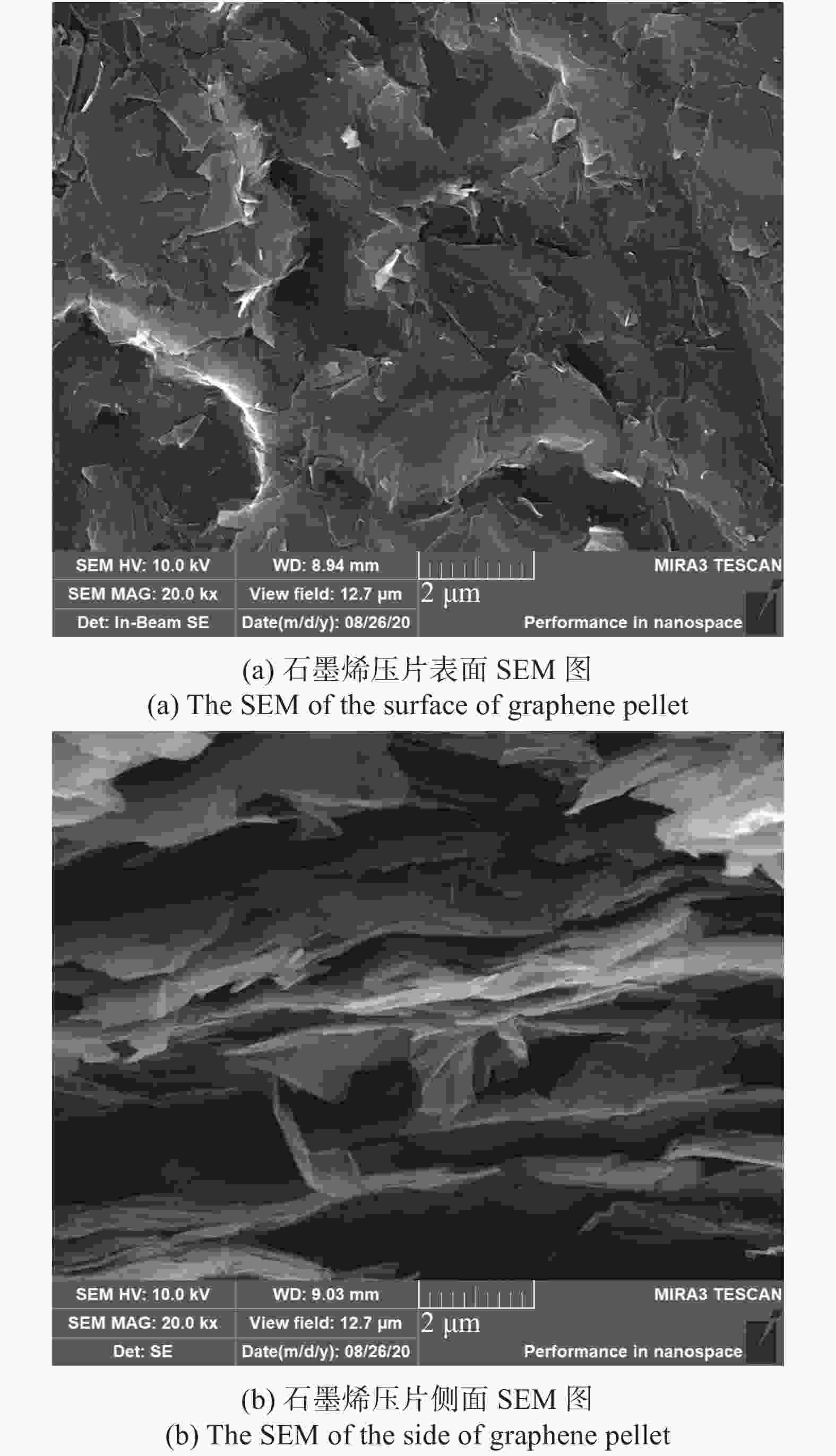
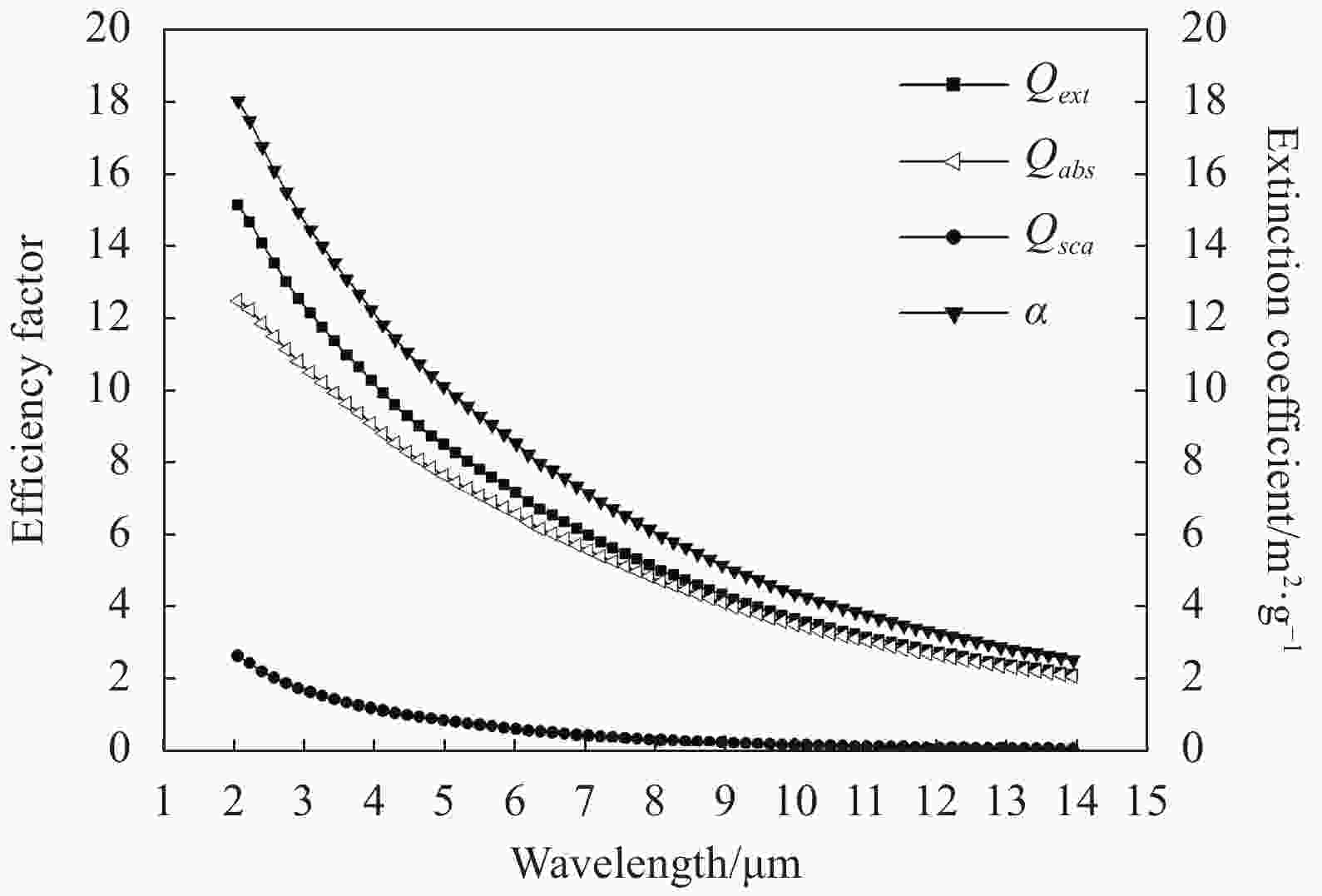
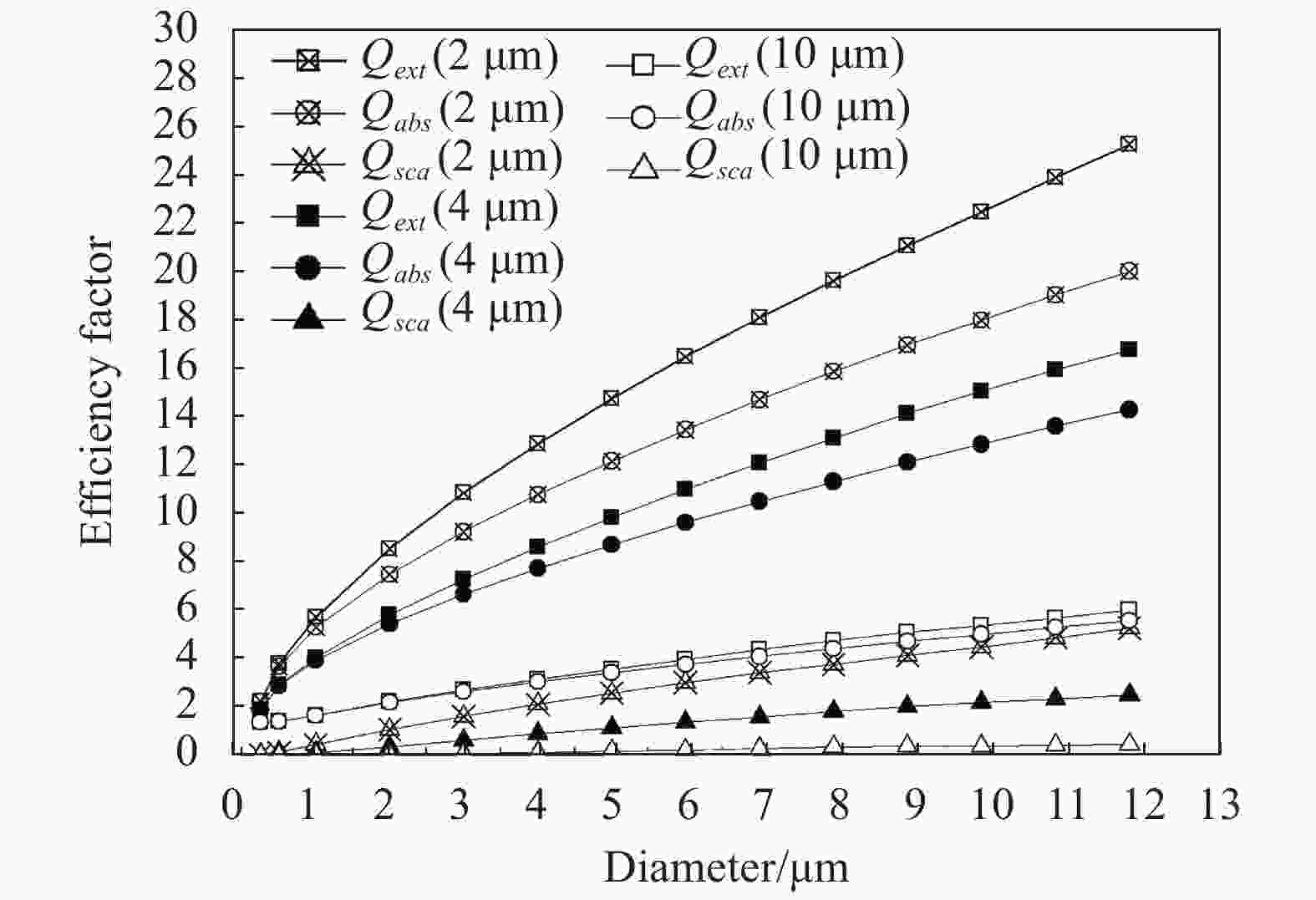


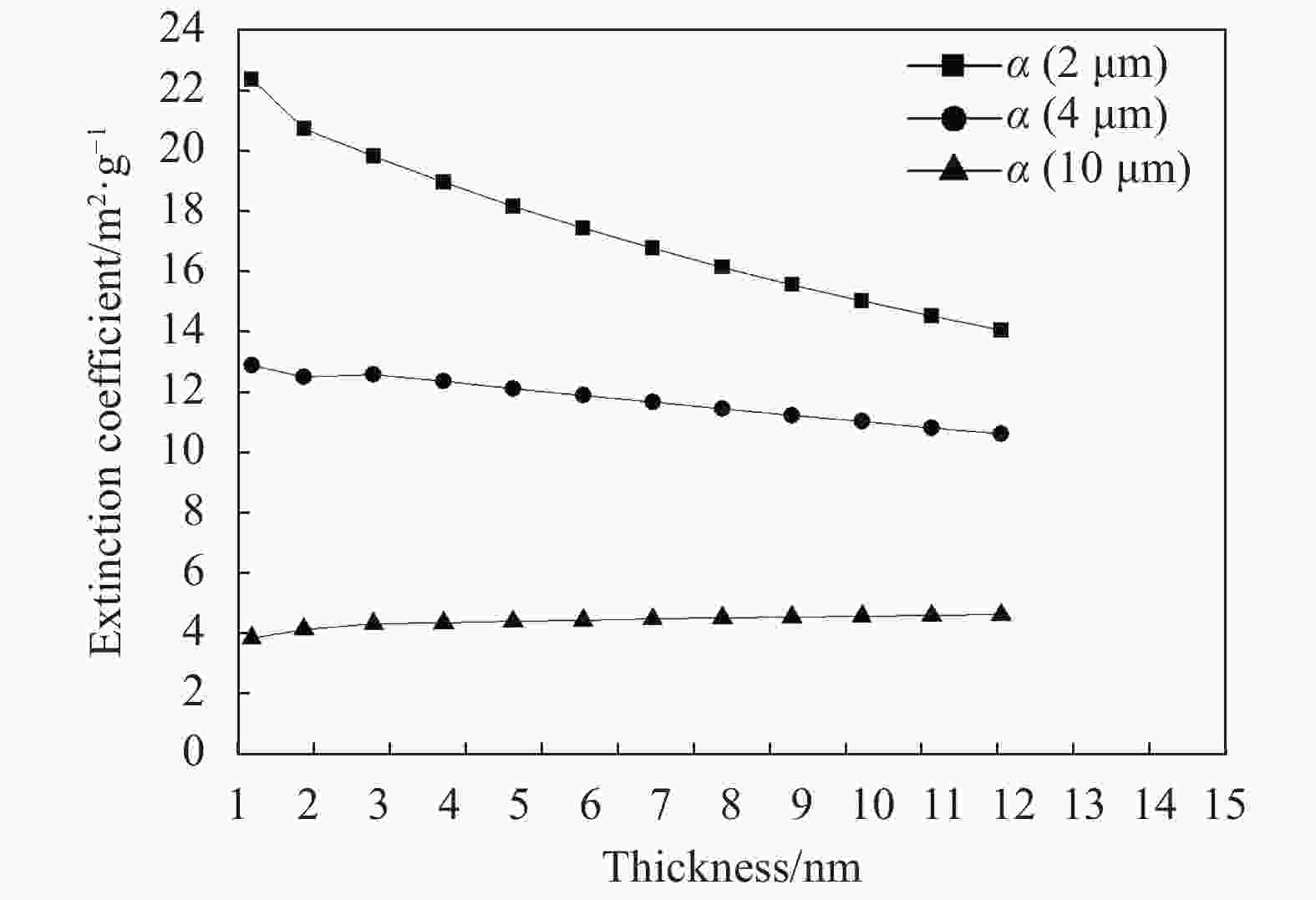

 DownLoad:
DownLoad:

